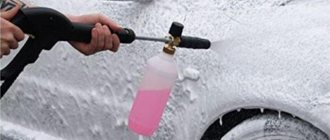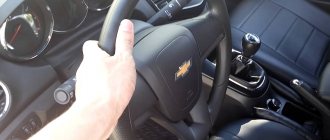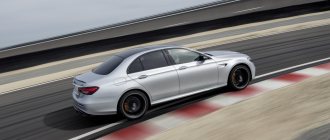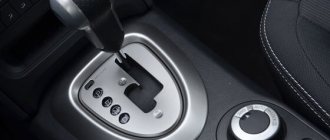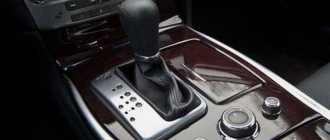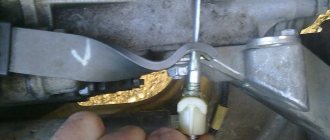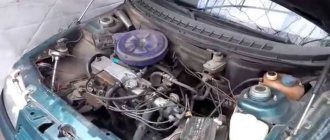Learning to move uphill without straining
Once, I had to observe the broken front of a Gazelle, antifreeze leaking from the radiator, and the upset driver of the damaged car. Formally, he was at fault: he didn’t keep his distance, he drove up too close.
But, considering that a car rolled onto him, the driver of which was moving poorly on the uphill, he had no chance of avoiding this accident. From the word absolutely. The hill at the traffic light was quite steep and the distance would have to be kept more than ten meters. Which is simply impossible in dense traffic.
What is a transmission?
In order to understand how to move off smoothly with a manual transmission, let’s look at the operation of the transmission. This unit is a set of mechanisms that provide gear shifting, as well as increasing and decreasing speed.
Important! The transmission transmits torque from the engine to the wheels of the vehicle.
If your car didn't have a transmission, you wouldn't be able to move away smoothly or change direction. This is one of the most important components of a car, on the health of which the safety of the driver and passengers depends.
Automatic and manual
The transmission can be either manual or automatic. In the second case, you won't have to change gears. Hydraulics will do everything for you. However, this does not mean that you do not need to know how to properly drive an automatic car.
Important! In turn, in order to move off smoothly with a manual transmission, you need to skillfully operate the clutch. Otherwise, the trip may end at the nearest pole.
When changing gears, the gear ratio changes. It is this parameter that affects the speed of the vehicle. In an automatic transmission and a manual transmission, the principle of changing this parameter is radically different.
In an automatic transmission, shifting occurs thanks to the brake band and clutch system. In mechanics, this process depends on two wheels, or more precisely, the difference between them. The larger it is, the higher the gear. When in neutral, neutral is engaged.
Attention! In an automatic transmission, an electronic control unit is responsible for controlling gear shifting.
We move up the hill smoothly and without jerking
Let's try to learn how to start on a hill, if this skill has not yet been honed to automaticity. With practice, so-called muscle memory appears and you will no longer need to remember the order of actions. The legs themselves will remember what movements to make. And your hearing will tell your head when to press down on the gas pedal and smoothly move forward.
You will learn to feel your car and this skill will not leave you anywhere. It's like riding a bicycle or skating - once you learn it, you won't forget it.
Every skill comes with practice. To drive, you need to drive and there are no other recipes.
The more often and longer the trips, the better and faster the driving skill will take root. The ability to correlate the capabilities of the car with the condition of the road will come, and so on and so forth.
You can rest assured that the ability to move away on an uphill slope smoothly and without jerking will definitely come.
Even if now you really want to cry when the car stalls or jumps, instead of moving smoothly upward. You will know on a subconscious level how to press the gas pedal, when to change gear and when to move your foot from the brake to the gas. All this will definitely come and stay with you forever.
How to avoid jerks?
Jerks occur due to insufficient smoothness of actions. The main mistake of all beginners is this:
- sudden release of the clutch;
- insufficient crankshaft speed;
The driver must train the left leg so that it can hold the pedal in a given position for a long time. Beginners release the pedal halfway and then activate the transmission-engine connection too quickly. The disc suddenly meets the flywheel and the car starts jerking. It is important to learn to drive so that the car does not jerk.
The second case occurs when the driver does not press the gas when starting to move. Especially when the car is heavily loaded and when driving up a high hill. If the vehicle is loaded or used to tow another vehicle. It is necessary to increase the crankshaft speed in advance, and then smoothly release the clutch to achieve a smooth start. These steps will help maintain the tow rope and teach you how to start with a load or uphill.
Let's start on an uphill climb without rolling back
The most difficult areas for us, the ladies behind the wheel, will be those with a large inclined angle. It was also difficult for me because my feet are small and my feet are narrow. Therefore, at first I kept getting caught when moving my foot from the brake to the gas between the pedals. Then this problem disappeared on its own. The leg remembered what movement it should make in order to land exactly where it should.
Universal algorithm of action
In driving school they teach you how to use the handbrake. Well, it has the right to life - let’s look at this method now.
You are on a climb, the engine is running, the handbrake is locked, the gearshift lever is in neutral.
- Depress the clutch and engage first gear.
- Lightly press the gas pedal.
At the same time, we bring the engine speed to 2500 rpm. Fix the gas pedal in this position. If you don’t yet have the ability to listen to the engine and determine by the sound the desired degree of holding the gas pedal, then we focus on the number of revolutions (the device, by the way, is called a tachometer). - Now release the gas pedal very slowly. This must be done smoothly and without jerking. We also release the clutch very smoothly. If you suddenly release the pedal, the engine will stall. We release the clutch until the speed on the tachometer shows approximately 1500 revolutions.
- Now the most important point - let go of the handbrake. If everything is done correctly, then you will move off without any problems. And remember - everything is done smoothly. Sudden movements will cause the engine to stall.
Let's go uphill without a handbrake
Everyday, common and, in my opinion, most acceptable.
- Starting position: gear shift lever in neutral, right foot on the brake pedal, handbrake not fixed (we don’t remember about it at all now, it’s not there and that’s it).
- First, depress the clutch and engage first gear. We made sure that nothing will interfere with the movement, we proceed further.
- Smoothly (smoothly!) release the clutch pedal until you hear the sound of the load on the engine (the brake is pressed). By the sound of the engine and by the slightly dropped speed on the tachometer, you can determine whether the clutch has engaged.
- The main thing with this method is to practice smooth movement of the clutch pedal
. If you suddenly “release” the clutch, the engine stalls. This sad thing is familiar to every novice car driver, and certainly to lady car drivers. All the ladies I know considered the clutch pedal, at the learning stage, enemy number 1. - Now release the brake (the clutch pedal is in the same position). Quickly, but smoothly, we throw our right, freed leg onto the gas, press the gas pedal and, lo and behold! - We move off elegantly.
That's it, the ability to feel the car has arrived and the ability to move away on an incline too. You can be proud of yourself, now you will enjoy driving and feel like an all-powerful tamer of an iron horse.
Likes 11
Clutch pedal positions
The clutch pedal has 4 main positions. For visual perception they are shown in the figure.
The distance from position 1, when the clutch is completely disengaged, to position 2, when minimal clutch occurs and the car starts to move, can be called an empty stroke, since when the pedal moves in this interval, nothing will happen to the car.
Range of motion from point 2 to point 3—adhesion force increases.
And the range from 3 to 4 points can also be called empty, since at this moment the clutch is already fully engaged, the car moves according to the selected gear.
In the ice!
In winter, many drivers do not use the handbrake.
After all, the pads of the drum mechanism often freeze and the wheel becomes blocked. Drivers of passenger cars put the car in gear. But how can they move if the car is slipping? It all depends on the thickness of the road surface. If the asphalt is covered with a thin layer of ice and water (no more than 2 mm), you can try to “dry” the area by slipping or start at high speeds. To do this, you need to make sure that there is no danger of the car skidding or free space ahead. 2nd gear is engaged, more revolutions are added and the tires will gradually crush the thin crust of ice.
If there is a thick layer of snow under the wheels, then you absolutely cannot skid. Otherwise, you will roll out the area so that you will not leave at all, or you will bury yourself in a hole. In this case, you should release the clutch as gently as possible, giving the wheel a barely noticeable movement. It is important to avoid slipping!
You can place a car mat under the wheel, or make grooves under it with a sharp object (for example, a scraper, a screwdriver). Of course, it is better to carry a little mixture of sand and salt with you.
The secret to a comfortable ride with a manual transmission is good starting from the clutch pedal on hills, country roads, parking maneuvers, without using the accelerator. Once this has been mastered to the level of reflexes, driving in winter or on mountain roads will not be difficult. Tags:
Step-by-step actions of the driver
Driving instructors usually provide theoretical explanations. They tell in detail the procedure for action in a given situation. Regarding stopping on a slope, below are three steps that must be followed in strict order in such a situation:
- To stop on a hill, press the brake pedal with your foot.
- The next step is to put the car on the handbrake.
- Control of all completed actions
There is nothing complicated, but you shouldn’t relax either. Let's move on to the following steps:
- Start the engine.
- Reach the second speed (2500-3000 rpm).
- Release the clutch gradually (1800-2000 rpm).
- Without unnecessary actions, the car must be removed from the handbrake.
- Together with the previous point, slowly add gas.
The above algorithm must be made automatic. Instructors constantly repeat these steps to their students in practice, and then demonstrate this on racetracks. Not everyone will be able to perform these actions automatically the first time, so sometimes you have to return to this algorithm.
This is interesting: How to enable autostart based on temperature on Starline b9
Machine
Every day, the automobile industry increasingly produces cars with automatic transmissions. This type of gearbox is more popular among motorists. But it’s true, if you have an automatic transmission, movement becomes a fairy tale, and you don’t have to think about what and how to press.
And indeed it is. But making the ascent in a vehicle that has an automatic transmission, not new, but previously used, is not so easy. When a steep hill is in sight, any motorist should know to shift into D or L because there is not enough power. But after fifteen minutes of driving at a speed interval of 20 km/h, the light begins to blink, indicating overheating. And if you stop on a slope, it will not be possible to continue moving. In such situations, it is recommended to promptly change the fluid and pay attention to the radiator.
If we take into account new models of vehicles with an automatic transmission, then when driving uphill, they do not have problems like current ones. Even in the case of forced restrictions in shifting the gearbox, but not higher than third gear and with maximum load, a car with an automatic transmission performs perfectly uphill. The same can be said about going down a slope. Motor vehicles are very good at slowing down using the engine, automatically switching to low gears.
If there is a very steep descent, it is recommended to engage the limit and preferably before second gear. And with this option, the vehicle will consume significantly less fuel, revving up the engine using kinetic energy (directly spare).
Now let's look at tugs based on automatic transmission. As you understand, this is not a manual transmission, and a car with an automatic transmission has some kind of limitations that you need to know about and always remember. And this applies not only to towing other vehicles that are subject to restrictions. Such a restriction sounds like this: it is allowed to take in tow only those vehicles whose weight is less than the main one. For example, it could easily be a small trailer. Although vehicles with automatic transmission move much slower with other cars in tow, they perform the task very well. True, here too you need to control overheating.
2: retracting box
The ideal way to feel the grip is by practicing on a matchbox. The assistant places an open matchbox in the frame of an open window or against a mirror. The driver’s task is to push it in as smoothly as possible.
The task can be complicated if you do it on a hill or the same ramp. The rollback will be immediately visible visually. Not all drivers will handle this exercise perfectly.
Maintain safety as attention is distracted by the boxes.
1: driving without gas
To get underway without rolling back, you need to feel the clutch perfectly. And to do this, practice the skill of setting the car in motion without adding gas, that is, using only the clutch pedal. This is easiest to do on an injection machine, which itself adds speed when the load on the engine increases. But even with a carburetor (diesel) this is quite possible. You can only add idle with a screwdriver to make it easier at first.
A level area is needed. Engage the gear, slowly release the clutch; when the car starts to move or shake, lock the pedal in place. As soon as the car travels 2-3 meters, release the clutch, drive a short distance and stop. Find a balance between driving and when the car stalls.
The feeling of grip has been refined to the level of a reflex. It usually takes several days of training to get it to perfection. After this, you can proceed to exercise 2.

